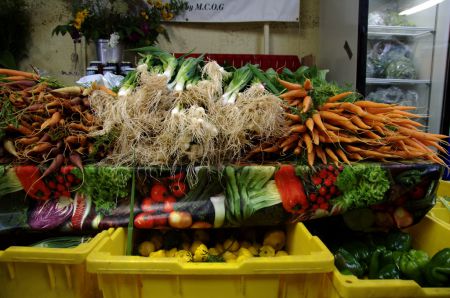K'JIPUKTUK (Halifax) - It was more than twenty-years ago when farmer Alan Stewart first began to sell his family’s produce at the weekly Wolfville Farmer’s Market.
“Back when I started farming there was no direct avenue to sell your product,” Stewart says. His family has been farming lands around Hortonville and Grand Pre for the past 100 years. “I got quite actively involved in the farmers’ market just to help it grow so I would have a place to sell my stuff.”
More than two decades later Stewart continues to sell his organic apples, berries and grapes at the market twice a week), along with 70 other vendors. Not only does he value the connection he’s been able to build with his customers, he is convinced that the market is the cornerstone of his business.
“I’ve gotten busier and so have other people.The pie’s gotten much larger, but we’ve been able to maintain our slice,” Stewart says with a smile.
On Friday, the Farmers’ Markets of Nova Scotia Co-operative brought together local farmers, businesses and community members to showcase the 2013 Nova Scotia Farmers’ Market Economic Impact Study.
“What we’re doing at farmers’ markets across the province is amazing,” said Keltie Butler, the co-op’s executive director. “It’s powerful and its’ changing communities and changing the story of Nova Scotia.”
The goal of the first-of-its-kind study was to highlight the success local farmers, young entrepreneurs and businesses experience at markets, she explains. The province-wide study examined 21 farmers’ markets to give a snapshot of the economic impact one market can have in a single day.
More than 55,000 people shop at a farmers’ market each week and spend between $16-$25 per visit, the report said. Among those markets that participated was the Lunenburg Farmers’ Market on Thursday that pulled in $60,000 and the Mabou Farmer’s Market that made $10,000 in one day.
“The Ivany Report and our provincial government are talking a lot about rural economic development and that’s what farmers’ markets are really all about,” Butler says.
She notes that the number of farmers’s markets jumped from 12 to 45 since the co-op began in 2004. Today, Butler says Nova Scotia is proudly home to the most farmers’ markets per captita in Canada
These markets support more than 1,500 local producers, according to the report.
For Butler and the co-operative, farmers’ markets offer Nova Scotians more than a healthy choice of food and a vibrant social atmosphere. They are the way to invest in the local economy and build a sustainable future.
Towns and cities benefit as much from farmers’ markets as do the farmers’ themselves, says Gordon Stevens, founder of the Uncommon Group — a coalition of locally owned and operated businesses. Over the past few years he has worked with a number of restaurants and bars to partner with rural producers to create, what he says, are relationships that benefit everyone — especially the city.
“If the goal of the city is to be relevant, vibrant and grow, then farmers’ markets are key,” he said. They just add so much vibrancy to the downtown. (Farmers’ markets) give you a reason to get up and come out of your house at 7 a.m. on a Saturday morning because there aren’t a lot of good reasons to get up on Saturday morning.”
He echoes the report that says people who shop at farmers’ markets also frequent surrounding local businesses and shops to spend an average of $16 to $29.
“But our story is also one of possibility.” Butler adds. “What if more Nova Scotians spent their money at farmers markets, doing their weekly shopping and taking in the fantastic atmosphere?”
Recently the co-op partnered with RedRiot, a Halifax-based branding firm to design a marketing campaign to encourage more people to do their weekly grocery shopping at markets.
“The provincial government has set a power goal that by 2020 they want to see 20 per cent of the food bought by Nova Scotiains being locally produced”, she said. “Farmers’ markets are undoubtably the key to reaching this impressive goal.”
In 2012, the Dexter government set this goal after a report by the Ecology Action Centre revealed a significant drop in the number of people who were eating local, says Marla MacLeod, the centre’s Food Connections Project Coordinator.
The report showed that in 1997, 17 cent per $1 of food purchased in Nova Scotia went back into farmers’ pockets. By 2008, that number had fallen to 13 cent per $1, she said.
In 2011, the Department of Agriculture last reported the province still sat at that number.
As a life-long farmer, Stewart is the first to admit that farmers’ markets are not the most efficient way to buy food. Big box supermarkets are cheaper and even faster, but he says the choice to buy local is about value and where people want to see their money go.
“If you want an anonymous relationship with your food there are supermarkets that allow you to do that,” he said.
But change is happening, MacLeod says. She has seen the number of new farms and young farmers grow across the province, which she speculates comes from increased interest in sustainability.
“A small group of people can make a big impact and that’s very true with farmers’ markets,” Butler says.



